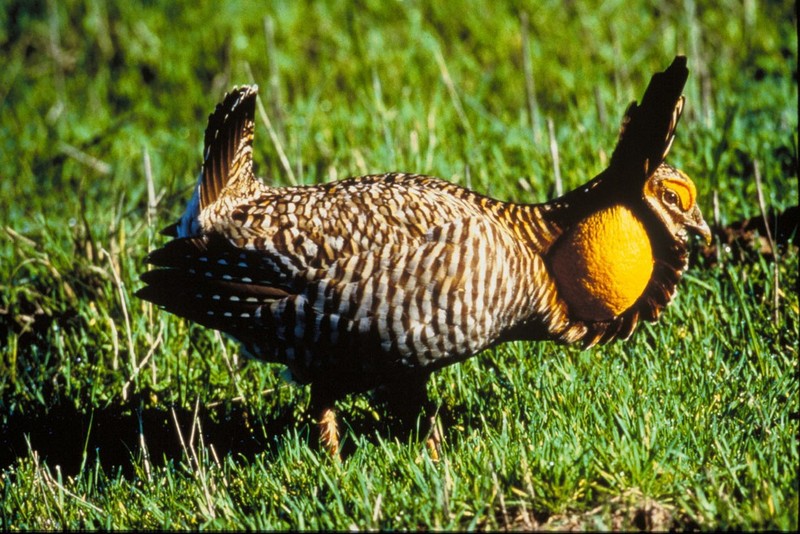|
| Query: bird | Result: 184th of 32671 | |
Attwater's Prairie Chicken (Tympanuchus cupido attwateri) - Wiki
| Subject: | Attwater's Prairie Chicken (Tympanuchus cupido attwateri) - Wiki
| |

| Resolution: 1123x750
File Size: 295133 Bytes
Upload Date: 2007:10:26 14:00:22
|
ERROR : (-30975)
ERROR : (-30975)
Attwater's Prairie Chicken (Tympanuchus cupido attwateri) - Wiki
Attwater's Prairie Chicken
From Wikipedia, the free encyclopedia
[Photo] Attwater's Prairie Chicken, Tympanuchus cupido attwateri. Creator: Lavendowski, George. Publisher: U.S. Fish and Wildlife Service. Rights: (public domain)
Attwater's Prairie Chicken (Tympanuchus cupido attwateri) is a highly endangered subspecies of greater prairie chicken related to the now extinct heath hen.
Over a century ago, one million Attwater's Prairie Chickens graced the Texas and Louisiana gulf coastal prairie. Today, less than 1% of their native coastal prairie habitat remains and in 1998 it was estimated that only 260 remained, with less than 60 living in the wild. Their sole refuges in the wild are the Attwater Prairie Chicken National Wildlife Refuge near Eagle Lake, Texas and another tiny parcel of land that was recently set aside near Texas City. There is also a small breeding colony residing on the grounds of the NASA Lyndon B. Johnson Space Center near Clear Lake, Texas. Captive breeding programs are underway at places such as Fossil Rim Wildlife Center, Texas A&M University, Seaworld of Texas, and the Houston Zoo.
The Attwater's Prairie Chicken measures 17-18 inches (43-45.5 cm) and weighs roughly 1.5 to 2 pounds (0.7 to 0.9 kg). It has a 28 inch (70 cm) wingspan. These grouse-like ground birds have strong vertical bars of dark brown and buff-white in a zebralike pattern over the mantle, flanks, and underparts. The species exhibits sexual dimorphism, with the males having elongated feathers, called pinnae, erected to form earlike structures. The male also has as a bright orange to reddish air sac on either side of his neck, which he inflates during mating displays.
The mating display can be seen in January or February when the birds gather in small groups on short grass, bare ground, rock outcroppings or hilly areas in order to choose a mate. This area is called a "booming ground" or a "lek". In these areas, the females watch the males and choose their mate. The male emits a booming, "woo-woo" sound from his throat sac and struts around to attract a female. Some of the traditional dances of the North American Plains Indians, notably those of the Lakota, are based on this booming display. Later, the hens build grass nests on the ground, hidden in tall grass, where they lay their eggs.
The bird has a diverse diet, eating leaves, seeds, and insects such as grasshoppers. Their predators include Red-tailed Hawks, owls, coyotes, raccoons, skunks, Opossum, and snakes. Many young birds also die from causes such as flooding.
Loss of habitat is believed to be the prime reason for their downfall. There was once 6 million acres (24,000 km²) of coastal prairie, now there is less than 200,000 acres (800 km²). In addition to loss due to urbanization, the entire prairie ecosystem where they once thrived no longer exists in the same form. Where once grazing bison and periodic fires due to lightning reduced ground cover, the birds now have difficulty making their way through thick undergrowth. It is possible that other less-apparent changes in the ecosystem have had an effect as well.
Attwater's Prairie Chicken has been on the endangered species list since March 1967.
http://en.wikipedia.org/wiki/Attwater%27s_Prairie_Chicken
| The text in this page is based on the copyrighted Wikipedia article shown in above URL. It is used under the GNU Free Documentation License. You may redistribute it, verbatim or modified, providing that you comply with the terms of the GFDL. |
|
Comments |
|---|
| | Guest |
|
| Awwwwww it's so cute i wish i could cuddle with it lol jk |
| | Guest |
|
| The Attwater’s prairie chicken (Tympanuchus cupido attwateri) is a grouse unique to the coastal areas of Texas and Louisiana. It is closely related to the Greater prairie chicken, which lives in the tallgrass prairies farther north. More than a century ago, an estimated one million Attwater’s prairie chickens inhabited their range. By 1937, approximately 8,700 birds remained, all in Texas. Attwater’s prairie chickens were listed as endangered in 1967, when only 1,000 birds remained. Today it is considered one of the most endangered birds in North America. |
^o^
Animal Pictures Archive for smart phones
^o^
|
|
|